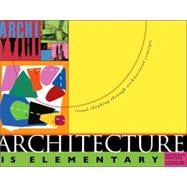
Note: Supplemental materials are not guaranteed with Rental or Used book purchases.
Purchase Benefits
What is included with this book?
| Acknowledgements | |
| Introduction | |
| Alike and Different | |
| Order | |
| Edges | |
| Shapes | |
| Size by Comparing | |
| Built Environment | |
| Repetition and Rhythm | |
| Units and Clusters | |
| Balance | |
| Pattern | |
| Measuring by Eye and Ruler | |
| Relating Parts of the Whole | |
| Contrast | |
| Architecture in Environment | |
| Planes | |
| Function and Form | |
| Shapes from Nature | |
| Scale | |
| Considering All Views | |
| Optical Weight | |
| Rhythm, Pattern, Movement | |
| A Identifying Architectural Styles | |
| B Ancient World Period | |
| C Early Christian Period | |
| D Medieval Period | |
| E Renaissance Period | |
| F Baroque Period | |
| G Revolutionary Period | |
| H Twentieth-Century Style | |
| Orders of Architecture | |
| Architectural Periods and Styles in Your Community | |
| Concave and Convex Forms | |
| Interesting Divisions of Space | |
| Symbolism (Building "Talk") | |
| Proportion | |
| Golden Mean | |
| Building Design for Special Needs | |
| Light and Shadow-Solar Energy | |
| Triangles | |
| Positive and Negative Forms and Spaces | |
| Mass Equals Geometric Bulk | |
| Symmetrical and Asymmetrical Space | |
| Roof Systems | |
| Organic and Mechanical Structures | |
| Hidden Patterns | |
| Complexity and Simplicity-A Balance | |
| Shadows | |
| Extending Points, Lines, and Planes to Make Form and Volume | |
| Architectural Groupings and Clusters | |
| Color | |
| City Planning | |
| Contrast as Used by Architects | |
| Order-the Most important Design Concept | |
| Proportion and Regulating Lines | |
| Adjusting Positive and Negative Spaces | |
| Naming Parts of Structures and Processes | |
| Planning Building Sites | |
| Postmodern, "Green" Architecture, and Deconstructivism | |
| Time Lines | |
| Glossary | |
| Table of Contents provided by Publisher. All Rights Reserved. |
The New copy of this book will include any supplemental materials advertised. Please check the title of the book to determine if it should include any access cards, study guides, lab manuals, CDs, etc.
The Used, Rental and eBook copies of this book are not guaranteed to include any supplemental materials. Typically, only the book itself is included. This is true even if the title states it includes any access cards, study guides, lab manuals, CDs, etc.